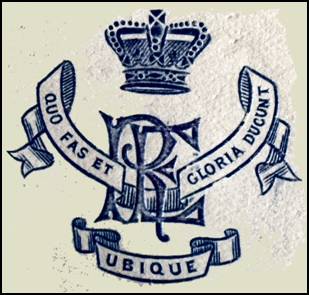
23068 Foreman of Works
Quartermaster Sergeant
EDWARD HOSKISON
(aka Isaac Edward R. Hoskison)
Royal Engineers
by
Lieutenant
Colonel Edward De Santis, MSCE, P.E., MInstRE
(2003, revised June 2022)

Figure 1. Crest of the Corps
of Royal Engineers (Victorian)
(Image courtesy of Stuart Gase)
1. INTRODUCTION
To begin the story of Edward Hoskisonís life and military service it is
first necessary to discuss his name. All
of his military service papers show his name to be Edward Hoskison.
A family tree found on Amazon.com as part of the Lane family tree (see
Reference section below) shows his name as Isaac Edward R. Hoskison.
Wherever family information was provided by Hoskison for his military
records that family information coincides exactly with information found in the
Lane family tree. The Lane family
tree does not reference Hoskisonís service papers, so it must be assumed that
the information was obtained independently from the military papers; therefore,
the name Isaac Edward R. Hoskison must also be assumed to have been his full
name. For reasons known only to him,
he chose to call himself Edward Hoskison when he enlisted in the Army.
He will be referred to as Edward Hoskison throughout this research except
where his name is cited in a document using his full name.
Unless otherwise noted, the majority of the details supplied in this narrative were extracted from Hoskisonís service papers, WO97/5161, obtained from the Public Record Office at Kew, Richmond, Surrey.[1] Secondary sources are primarily Hoskisonís family tree and census data from 1871 to 1911.
Early
Life
Edward Hoskison was born in the Parish of Patrington,[2] near the Town of Hull[3] in the County of Yorkshire in February of 1867. As stated in his service papers, he and his family were members of the Church of England. As a young man, Hoskison worked as a Surveyor's Apprentice for Mr. W.H. Wellsted of Hull. He also appears to have had some skills as a draughtsman. The knowledge and skills he gained while working for Mr. Wellsted undoubtedly was considered an asset when he decided to enlist in the Corps of Royal Engineers since surveyor and draughtsman were both considered to be Corps Trades.
Family
Information
Edwardís father, Thomas Hoskison (1817-1879) was born in Wilnecote, Warwickshire on 6 May 1917. He married Sarah Atkinson (1828-1861) at Patrington, East Yorkshire on 2 November 1847. Thomas and Sarah had six children before Sarah died in October 1861 at the age of 33. Thomas married Ann Dunn (1833-1917) in Patrington on 5 April 1864. They had three children; Frances Mary Hoskison (1865-1867), Isaac Edward R. Hoskison (1867-1922) and Olive A.T. Hoskison (1869-1950).
Since Edward was born in 1867 the first census in which he appears is the 1871 Census of England, the details of which are shown in the table below. The 1871 census form is rather difficult to interpret because it does not indicate the road or street name next to the residence of each family. In the Description of Enumeration District on the census form the Enumerator, on Mr, Alexander P. Firth, lists a number of lanes and roadways where people were living and he numbered the houses sequentially from Humber Lane to Wineshead Road. He did not indicate the road of the Hoskison residence, only to assign it number 11 on the road.
1871
Census of England (RG 10/4798)
|
Address:
No. 9 Patrington Parish,
Yorkshire. |
|||||
|
Name
and Surname |
Relation |
Marital
Status |
Age |
Profession
or Occupation |
Birthplace |
|
Thomas
Hoskison |
Head |
Married |
51 |
Spirit
Merchant, Brewer |
Wilnecote, |
|
Ann
Hoskison |
Wife |
Married |
36 |
|
Ottringham, |
|
Ann
E. Hoskison |
Daughter |
Single |
19 |
|
Patrington,
|
|
Isaac
E.R. Hoskison |
Son |
|
4 |
|
Patrington,
|
|
Olive
Hoskison |
Daughter |
|
1 |
|
Patrington,
|
|
Charlotte
Harness |
Servant |
Single |
20 |
Domestic
Servant |
Ottringham, |
NOTE: The census shows that Ann Elizabeth Hoskison (1852-?), a daughter by Thomasís first wife, was living in her fatherís household at the time. Ann was the eldest of Thomasís children by his first wife.
The size of the
Hoskison family was much reduced by 1881 as shown in the census below.
1881
Census of England (RG 11/4785)
|
Address:
114 West Gate, Patrington,
Yorkshire. |
|||||
|
Name
and Surname |
Relation |
Marital
Status |
Age |
Profession
or Occupation |
Birthplace |
|
Ann
Hoskison |
Wife |
Widow |
46 |
Wine
& Spirit Merchant, Brewer |
Ottringham, |
|
Isaac
E.R. Hoskison |
Son |
|
14 |
Scholar |
Patrington,
|
|
Olive
Hoskison |
Daughter |
|
11 |
Scholar |
Patrington,
|
Thomas Hoskison had died in 1879 so Ann became the head of the family
and appears to have taken over the family business.
Ann Elizabeth Hoskison had left the household and was probably out on her
own. The family tree provided no
information about her in 1881. She
may have married. There was no
domestic servant working in the house in 1881, presumably because Ann Hoskison
could not afford to pay a servant after her husband died.
Hoskison's military records show that prior to his enlistment in the Army in 1888 he lived with his mother, Ann Hoskison, at 7 Jarrett Street in Hull, Yorkshire.[4]
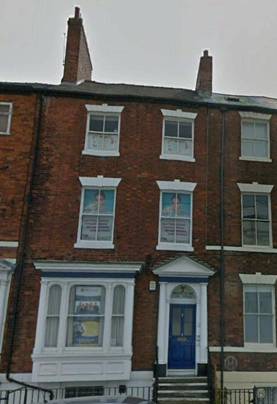
Figure 2. 7 Jarrett Street,
Hull.
(Photograph courtesy of Google Earth)
3. PHYSICAL DESCRIPTION
By the standards of the late Victorian period, Edward Hoskison was a big man. The following is a description of him at the time he enlisted in the Army in 1888:
|
Age: |
21 years and 6 months |
|
Height: |
5 feet 10Ĺ inches |
|
Weight: |
182 pounds |
|
Chest Measurement: |
38 inches |
|
Complexion: |
Fresh |
|
Eyes: |
Blue |
|
Hair: |
Light brown |
|
Distinctive Marks: |
Vaccination mark on the left arm |
|
Age: |
42 years and 6 months |
|
Height: |
5 feet 10Ĺ inches |
|
Chest Measurement (normal): |
47Ĺ inches[5] |
|
Chest Measurement (expanded): |
50 inches |
|
Complexion: |
Fair |
|
Eyes: |
Blue |
|
Hair: |
Light brown |
|
Distinctive Marks: |
None |
Enlistment
Edward Hoskison was recruited for enlistment in the Royal Engineers on 15 August 1888 by a Sergeant Bushby of the East Yorkshire Regiment at the 15th Regimental District depot in Beverley, Yorkshire. At the time of his enlistment he was asked the routine questions normally put to a recruit. He indicated that he had been an Apprentice, that he was not married and that he had never been imprisoned by civil power. He further indicated that he had never served in the Regular Army, Royal Navy or Militia, he had never been previously discharged from Her Majesty's forces and that he had never been rejected as unfit for military service. In fact, prior to his enlistment, he had served in the 2nd East Yorkshire Artillery Volunteers with headquarters located at Hull, apparently for only one day.[6]
Hoskison attested for service at Beverley on the same day as his enlistment. His was a Short Service enlistment for a period of 7 years with the Colours and 5 years in the Reserve.[7] Lieutenant Colonel J. McD. Allardice, the commander of the 15th Regimental District, certified his attestation. Hoskison's Certificate of Final Medical Examination was completed by J. Hoysted, the Brigade Surgeon at Beverley. He was found to be fit for service in the Army by "Special Authority." There is no indication in his service papers describing this "Special Authority" or why it was required. It appears that Hoskison may have had some medical condition that ordinarily would have made him unfit for service. It appears, however, that his civil trades as a Surveyor's Assistant and as a Draughtsman may have been sufficient for his condition to be waived.
A Primary Military Examination was administered to Hoskison at Beverley by the Recruiting Officer of the 15th Regimental District. He was certified fit for service in the Royal Engineers, no doubt because of his prior training and skills as a Surveyor's Assistant and Draughtsman. Following these certifications, Lieutenant Colonel Allardice gave his final certification of Hoskison's enlistment as the Approving Field Officer.
Training
Hoskison reported to the School of Military Engineering at Brompton Barracks in Chatham, Kent on 17 August 1888. There he was assigned Regimental Number 23068 and the rank of Sapper. His skills as a draughtsman were evaluated upon his arrival at Chatham and were noted to be "Good." He then entered into a period of recruit training to learn the skills required of an engineer soldier.[8]
Sapper Hoskisonís training began with the basics that were required for each man to learn to be a soldier. This involved military customs, the wearing of his uniform and insignia, military discipline and the use, care and maintenance of his weapon. Following a period of basic training, Hoskison then received the training necessary to make him an engineer soldier. This involved such field engineering subjects as tunnelling, trench-building, bridging and other skills necessary to support the infantry, cavalry and artillery in the field.
5. ASSIGNMENTS AND
CAMPAIGN SERVICE
Chatham
(1888-1892)
Upon completion of his recruit training it appears that Sapper
Hoskison remained at Chatham and completed a course of instruction as a
Draughtsman. Although he was a
"Good" Draughtsman when he enlisted, the Army wanted to provide him
with additional training probably so that he could learn the elements of
military drawing. His total time at
Chatham appears to have been on the order of three and a half years, or about
two years beyond what would normally have been his recruit training.
The
Curragh (1892-1894)
Following a period of leave, Hoskison left Chatham for the Curragh in Ireland. As with so many records of soldiers in the Royal Engineers during the Victorian period, his service papers do not show to which unit he was posted at this time. During the time that Hoskison served at the Curragh, the General Officer Commanding (GOC) was Major-General Lord Ralph Drury Kerr, CB (1837-1916).[9] The garrison then consisted of the 1st Battalion Royal Irish Regiment, the 1st Battalion Lancashire Fusiliers and the 2nd Battalion Worcestershire Regiment (31st Foot). In 1894, the Worcestershires were replaced by the 2nd Battalion the Hampshire Regiment. The units of the Royal Engineers that were at the Curragh for various periods during his time there were the 12th, 17th and 23rd Field Companies and the 29th Fortress Company. Hoskison could have served in any one of these units.
It appears that Hoskison served at the Curragh for a period of two to two
and half years before being posted to Aldershot.
Again, his service papers are not specific with regard to his date of
transfer or the unit to which he was posted.
Aldershot
(1894-1895)
While at Aldershot Hoskison was promoted to the rank of 2nd
Corporal. It appears that Army life
agreed with him, for on 30 July 1895 he extended his enlistment to complete 12
years with the Colours.[10]
The 23rd and 38th Field Companies were at Aldershot
during 1894 and 1895, so it is possible that Hoskison served with one of these
units. In fact, if he had served with the 23rd Field Company in the
Curragh, he may have transferred with that company when it moved to Aldershot.
His daughter Anne Esther was born while he was serving at Aldershot.
Bermuda
(1895-1899)
On 5 November 1895, Hoskison left England for his new posting to the 36th (Fortress) Company on the island of Bermuda. Since his marriage had not been recognized at this time, it is not known for certain whether his wife and daughter accompanied him to Bermuda.
The
role of a fortress company was to assist in the defence of ports and harbours
that had significant military importance. This
was accomplished by the use of mines and searchlights and by supporting the
Royal Artillery garrison co-located with the fortress company.
A Royal Engineers fortress company typical would provide the following
services in defence of ports and harbours:
Hoskison apparently continued to enjoy army life for on 30 October 1899
he re-engaged to complete 21 years of service with the Colours.
His re-engagement was approved by the Commander Royal Engineers (CRE)
Bermuda.[11]
Liverpool
and Preston (1899-1904)
Hoskison's tour of duty on Bermuda lasted until about late November of 1899 when he was ordered home. He arrived in England on 7 December 1899 and although many companies of the Royal Engineers were preparing to go to South Africa, Hoskison was not posted to one of these units, thereby missing his opportunity to see active service during the Boer War of 1899-1902.[12] Instead he was posted to the office of the Commander Royal Engineers (CRE) in Liverpool, the headquarters of which was at 14 Elliott Street in the town of Liverpool.[13] However, Hoskison did not remain in Liverpool. He was posted to a District Office located at Preston in Lancashire, an office that came under the control of the CRE Liverpool. The 1901 Census of England shows Edward Hoskison, age 33, at Fulwood Barracks in Broughton, Preston, Lancashire. The Hoskisonís son Thomas was born while he was serving in Preston.
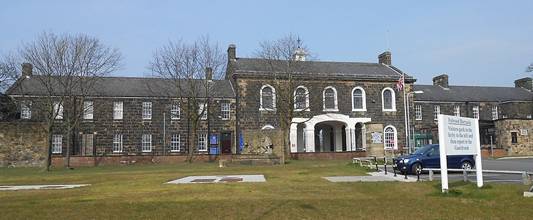
Figure 3. Fulwood Barracks,
Preston, Lancashire.
(Photograph courtesy of Wikipedia)
Hoskison remained at Preston until 1 July 1904 when he departed England
for the island of Mauritius in the Indian Ocean.
His marriage had been recognized by this time and it is very likely that
his wife and children accompanied him on this posting.
Mauritius
(1904-1907)
The Royal Engineers on the island of Mauritius in 1904 consisted of the office of the CRE Mauritius (Brevet Colonel F.H. Horniblow, R.E.) with headquarters at Vacoas[14] and the 43rd (Fortress) Company, Royal Engineers. The 43rd (Fortress) Company performed duties on Mauritius much like those performed by the 36th (Fortress) Company on Bermuda. As a member of the Supernumerary Staff of the Royal Engineers it is most likely that Hoskison was serving in the office of the CRE during his time on Mauritius, rather than with the company, although it is likely that he was on the roster of the company for administrative purposes. He remained there until 26 November 1907 when he and his family arrived back in England.
Dover
(1907-1909)
Hoskison's next assignment was in the office of the CRE Dover District located at Archcliffe Fort in Kent. He was then serving with the Establishment for Engineer Services[15] and was again working for Colonel F.H. Horniblow, R.E. who must have left Mauritius to return to England at about the same time as Hoskison. Hoskison served in this assignment until the summer of 1909 when he applied for discharge upon the termination of his second period of limited engagement.
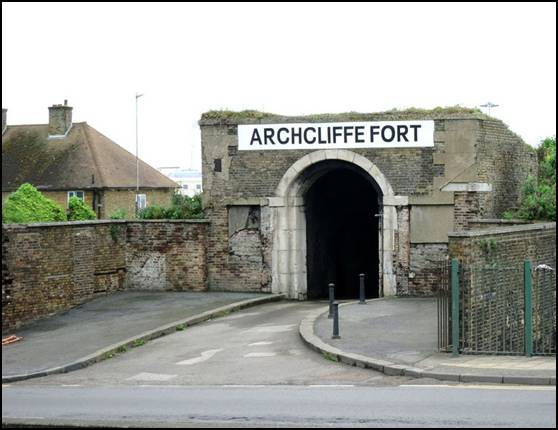
Figure 4. Entrance to
Archcliffe Fort.
(Photograph courtesy of Castle and Fortifications of England & Wales)
________________________________________________________________
The following sections are presented in tabular form to summarize
Hoskisonís promotions,
appointments, military training and qualifications and the medal that he was
awarded during his time in the Army. They
are provided to give the reader easy access to these aspects of his military
career. The tables are followed by
sections dealing with his marriage, personal information and post-service life.
__________________________________________________________________________
6.
PROMOTIONS AND CONDUCT
a. Promotions: Edward Hoskison received the following promotions during his time in service:
Date of Promotion or Appointment |
Rank
or Position |
|
15 August 1888 |
Appointed Sapper on enlistment. |
|
3 March 1893 |
Appointed Lance Corporal. |
|
1 June 1895 |
Promoted 2nd Corporal. |
|
1 July 1898 |
Promoted Corporal. |
|
28 December 1900 |
Promoted Foreman of Works Staff Sergeant. |
|
28 March 1907 |
Promoted Foreman of Works Quartermaster Sergeant |
Date of Award |
Good
Conduct Badge |
|
15 August 1890 |
Authorized Good Conduct Pay at 1d per day. |
|
15 August 1894 |
Authorized Good Conduct Pay at 2d per day. |
On 15 August 1906 Foreman of Works Staff Sergeant Edward Hoskison completed 18 years of service with the Colours and became eligible for the award of the Long Service and Good Conduct Medal. This medal subsequently was awarded to him in accordance with Army Orders dated April 1907.[17] The Long Service and Good Conduct Medal (EVIIR) is the only medal that Hoskison earned during his 21 years of service in the Army. As previously mentioned, other than numerous campaigns on the North West Frontier of India, the only significant military action during Hoskisonís time in the Army was the South African War of 1899 to 1902. He was not involved in any of these.
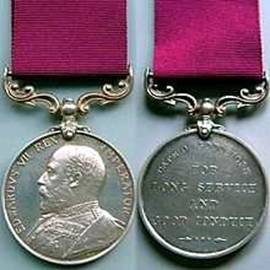
Figure
5. The Long Service and Good Conduct
Medal of Foreman of Works
Quartermaster Sergeant Edward Hoskison.
(Photograph from the authorís collection)
The medal is
named to him on the rim in upper case letters as follows:
23068
F. OF W.
S.SJT. E.HOSKISON. R.E.
At the time of his discharge in 1909, Hoskison's conduct was rated as "Exemplary" by his commanding officer with a notation on his discharge papers indicating that he had committed no offenses during his 21-year period of service. This would indicate that his name never appeared in the Regimental Defaulters Book and that he had never been court-martialed.
a. Education: Edward Hoskison earned the following Certificates of Education during his time in service:[18]
Date |
Certificate
of Education |
|
5 December 1889 |
Awarded a 3rd Class Certificate of Education |
|
16 October 1893 |
Awarded a 2nd Class Certificate of Education |
|
28 March 1907 |
Awarded a 1st Class Certificate of Education |
Date |
Qualification |
|
17 August 1888 |
Qualified as a "Good" Draughtsman immediately following his enlistment. |
|
25 November 1890 |
Completed the course of instruction as a Draughtsman with a qualification of "Superior." |
|
1900 |
Qualified as a Military Foreman of Works. |
|
28 December 1900 |
Appointed to the Supernumerary Staff.[19] |
|
1 April 1904 |
Awarded Service Pay Class I at 7d per day.[20] |
|
14 August 1909 |
Qualified as a "Very Superior" Draughtsman upon discharge. |
The following medical information was taken from Edward Hoskison's service records during his time in the Army. His Medical History Sheet was not found in his records under WO97/5161. The missing Medical History Sheet might have provided information regarding a physical condition, if any, that required Hoskison to be enlisted by "Special Authority."
Location |
Date
of Admission |
Ailment |
Period
of Hospitalization or
Treatment |
|
Chatham, Kent[21] |
3 Feb 1892 |
Sprained ankle |
Not stated in service record. |
|
Curragh, Ireland |
10 Aug 1892 |
Sprained left knee |
Not stated in service record. |
Edward Hoskison married Esther Burke, a spinster, at St. Joseph's Catholic Church in Aldershot, Hampshire on 25 November 1894, without leave.[22] They were married by Father E.A. Riordan with Herbert and Catherine Nice acting as witnesses at the wedding. It was not until 15 June 1904 that their marriage was recognized by the Army. On that date Hoskison was placed on the married rolls and his wife Esther was taken on the strength of his unit. It is curious that although the Hoskison family were members of the Church of England, as stated on Edward Hoskisonís enlistment papers, he chose to be married in a Catholic church. Perhaps his wife, Esther Burk was Catholic.
Edward and Esther Hoskison had two children while he was serving in the Army. Their daughter Esther Ann was born at Frimley, Surrey on 30 August 1895. Frimley is located approximately five miles north of Aldershot, Hampshire. Their son Thomas was born at Fulwood near Preston in Lancashire on 18 June 1903.
11. DISCHARGE
Foreman of Works Quartermaster Sergeant Edward Hoskison was discharged from the Army at Brighton, Sussex on 14 August 1909 on the termination of his second period of limited engagement. His total service was reckoned as shown in the tables below:
Location |
Period
of Service |
|
Beverley, Yorkshire |
15-16 August 1888 |
|
Chatham, Kent |
17 August 1888 - November 1890 |
|
Curragh, Ireland |
November 1890 - November 1894 |
|
Aldershot, Hampshire |
November 1894 - 4 November 1895 |
|
Bermuda |
5 November 1895 - 6 December 1899 |
|
Preston, Lancashire |
7 December 1899 - 30 June 1904 |
|
Mauritius |
1 July 1904 - 25 November 1907 |
|
Dover, Kent |
26 November 1907 - 14 August 1909 |
Location |
Period
of Service |
|
Home Service |
13 years and 186 days |
|
Service Abroad |
7 years and 179 days |
Total Service |
21 years exactly |
At the time of his discharge, Edward Hoskison indicated that his intended
place of residence upon leaving the Army would be 50 Buller Road in Brighton,
Sussex. Although this might have
been his intended place of residence, by 1911 he and his family were living in
Portsmouth, Hampshire.
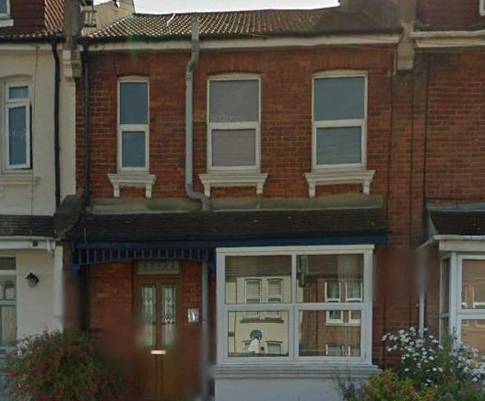
Figure 6. 50 Buller Road,
Brighton.
(Photograph courtesy of Google Earth)
12. POST SERVICE LIFE AND
FAMILY INFORMATION
Post
Service Life
The only information regarding Quartermaster Sergeant Hoskisonís post
service life was found in the 1911 Census of England and Wales and shown in the
table below. It appears that as an
Army Pensioner he was able to secure a position as a Clerk in the War
Department. Just which agency of the
War Department he worked for in Portsmouth is not known.
1911
Census of England and Wales
|
Address:
2 Clegg Road, Eastney,
Portsmouth, Hampshire |
|||||
|
Name
and Surname |
Relation |
Marital
Status |
Age |
Profession
or Occupation |
Birthplace |
|
Edward
Hoskison |
Head |
Married |
44 |
Army
Pensioner Clerk, War Department |
Patrington, |
|
Esther
Hoskison |
Wife |
Married |
39 |
|
Gibraltar |
|
[Anne]
Esther Hoskison |
Daughter |
Single |
15 |
School |
Preston, |
|
Thomas
Hoskison |
Son |
Single |
15 |
Scholar |
Aldershot, |
|
Victor
Penny |
Boarder |
Single |
24 |
Grocer
Shop Assistant |
Bradford
on Avon, Wiltshire |
NOTE: Anne Esther is noted simply as Esther in the census.
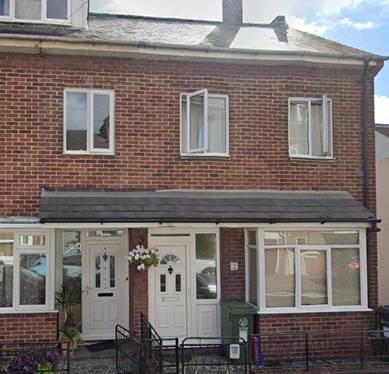
Figure 7. 2 Clegg Road,
Eastney, Portsmouth, Hampshire.
(Photograph courtesy of Google Earth)
Family
Information
Parents
Edward Hoskisonís father, Thomas, was born on 6 May 1817 in Wilnecote, Warwickshire. He was the son of Thomas Hoskison (1787-1833) also of Wilnecote. Thomas first married Sarah Atkinson (1828-1861) in Patrington, East Yorkshire on 2 November 1847. After Sarahís death in October 1861, Thomas married Edwardís mother, Ann Dunn (1833-1917) in Patrington on 5 April 1864. Thomas Hoskison died in Patrington on 17 June 1879, aged 62.
Ann Hoskison lived with her husband in Patrington and had three children
there with him. She continued to
live in Patrington for about two years after Thomasís death when she moved to
Sculcoates, Yorkshire. Ann Hoskison
died in Hull, East Yorkshire in 1917, aged 84.
Wife
Edward Hoskison married Esther Burk on 25 November 1894 in St. Josephís Catholic Church in Aldershot, Hampshire. Esther was born in Gibraltar, and as Catholicism was the predominant religion in Gibraltar, Esther was probably a Catholic; hence, their marriage in a Catholic church. Although Edwardís family were members of the Church of England, he appears to have agreed to Estherís wish to be married as a Catholic. No information could be found regarding Estherís family, so specific information about her familyís religion could not be found.
Children
Edward and Esther Hoskison had two children. Their first child, Anne Esther (1895-?) with born on 30 August 1895 at Frimley, Surrey, a town about seven miles due north of Aldershot where Edward Hoskison was posted at the time. No additional information could be found regarding Anneís life. Their second child, Thomas (1903-1973), was born in Fulwood, Lancashire on 18 June 1903 while Hoskison was serving at the District Engineer Office in Preston. Thomas would have been too young to have served in the Great War of 1914-1918. No information could be found regarding his later life.
Siblings
Edward Hoskison had two half sisters and four half brothers by his fatherís first marriage. These siblings were:
∑
Ann Elizabeth Hoskison (1852-?)
∑
Thomas Hoskison (1853-1934)
∑
Henry John Hoskison (1856-1856)
∑
Kate Hoskison (1858-1858)
∑
Charles Hoskison (1860-1863)
∑
Walter Hoskison (1861-1861)
As can be seen, Henry, Kate and Walter lived for less than a year after they were born and Charles lived for only three years. Thomas and Sarah Hoskison must have suffered greatly as they lost three of their new-born children between 1856 and 1863 and one infant child during that same period. Sarah actually died in 1861 at the age of 33, so she never knew of the death of her son Charles. She may have died of grief.
When his father married for a second time after the death of his first wife, he and his wife had two children in addition to Edward. Frances Mary Hoskison (1865-1867) was born in Patrington in July 1865 and she died in October 1867. Thomas Hoskisonís grief continued even after his second marriage. He had lost four children and his first wife between 1856 and 1863 and then lost another child by his second wife in 1867.
Olive A.T. Hoskison (1869-1950) also was born in Patrington on 11 November 1869. Olive married one Thomas Escritt (1868-?) of Newcastle Upon Tyne, Northumberland in 1918. She died in Hull on 14 April 1950.
REFERENCES
Books
1. BAKER BROWN, W. The History of the Corps of Royal Engineers. Volume IV. The Institution of Royal Engineers, Chatham, Kent, 1952.
2. FARWELL, B. Mr. Kiplingís Army: All the Queenís Men. W.W. Norton & Company, New York, 1981.
3. GRIERSON, J.M. Scarlet Into Khaki: The British Army on the Eve of the Boer War. Greenhill Books, London, 1988.
4. SKELLEY, A.R.
The Victorian Army at Home: The
Recruitment and Terms and Conditions of the British Regular, 1859-1899.
McGill-Queenís University Press, Montreal, 1977.
Census
1. 1871 Census of England (RG 10/4798).
2. 1881 Census of England (RG 11/4785).
3. 1901 Census of England (RG 13/3963).
4.
1911 Census of England (RG 26/5547).
Computer Software
1881 British Census and National Index.
The Church of Jesus Christ of Latter-day Saints, Salt Lake City, 1999.
Documents
1.
Short Service Attestation Papers (Army Form B. 265) consisting of
the following pages and sections:
a. Questions to be put to the Recruit before Enlistment.
b. Oath of Attestation.
c. Certificate of Magistrate or Attesting Officer.
d. Description on Enlistment.
e. Certificate of Primary Medical Examination.
f. Certificate of Final Medical Examination.
g. Certificate of Primary Military Examination.
h. Certificate of Approving Field Officer.
i. Statement of Services
Military History Sheet.
2. Proceeding on Discharge (Army Form B. 268).
Family Trees
Lane Family Tree:Ancestry.com: Isaac Edward R. Hoskison (1867-1922)
Internet Web
Sites
1. Castles and Fortifications of England & Wales.
http://www.ecastles.co.uk/archcliffe.html
2. Fulwood Barracks
By
Rept0n1x - Own work, CC BY-SA 3.0, https://commons.wikimedia.org/w/index.php?curid=31933684
Periodicals
Monthly Army List, September 1885.
ENDNOTES
[1] Now known as The Public Records Office.
[2] Patrington is located approximately 14 miles southeast of the present town of Kingston upon Hull.
[3] When Hoskison was born, the present day town of Kingston upon Hull was known simply as Hull.
[4] A review of the 1881 British Census did not produce any information about Ann Hull or any other members of Edward Hoskison's immediate family.
[5] By the time he was discharged in 1909 his chest size had increased by about 10 inches. Although his weight is not shown at the time of discharge, he certainly must have been well over 200 pounds.
[6] Monthly Army List, September 1885, p. 219.
[9] Born on 11 August 1837, Lord Ralph Drury Kerr was the third son of John William Robert Kerr, 7th Marquess of Lothian, by his wife Lady Cecil nťe Chetwynd-Talbot, daughter of the 2nd Earl Talbot of Hensol. He entered the 10th Hussars as a Cornet on 24 November 1857, reaching the rank of Major-General in 1890. He served with distinction in the Afghan War 1878-1879, including the action at Futtehbad (mentioned in despatches, medal, and C.B.). From 1891 to 1896 he commanded the Curragh District (Army and Navy Gazette, 13 February 1897).
[12] His not being assigned to active service in South Africa may have been due to the requirement for his trade and experience or it may have had something to due with the physical limitations that required he be granted "Special Authority" to be considered fit for military service.
[13] Now a shopping mall known as Clayton Square.
[14] Vacoas is a town in western Mauritius, located about 10 miles south of the city of Port Louis.
[16] See Good Conduct Pay.
[17] This medal is in the author's collection.
[18] See Certificates of Education.
[20] Service Pay in addition, to their regular pay, was granted to men in the Royal Engineers who demonstrated proficiency in their military trades. Service Pay was awarded in seven classes, with Class I being the highest.
[21] Hoskison sprained his ankle while on leave. It appears that this accident may have occurred after leaving the School of Military Engineering at Chatham and prior to reporting to his new company at the Curragh in Ireland.